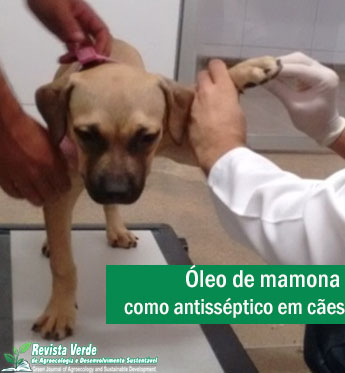Undecilenic acid of mamone oil as antisseptic in dogs
DOI:
https://doi.org/10.18378/rvads.v13i4.5631Keywords:
Domestic animals, Microorganisms, Ricinus communisAbstract
The present study aimed to evaluate the possibility of using undecylenic acid, extracted from castor oil (Ricinus communis), as an antiseptic in dogs (Canis lupus familiaris). For this purpose, a prototype of a treadmill, made of castor resin, covered with an acid impregnated adhesive mat, on which the animals of the study were walked, was used. The work was developed with 54 dogs and the samples of the swabs of the cushions were collected from the right (control) and left (test) anterior limbs, and the control and test samples were collected, respectively, before and after the use of the treadmill. After the collection, the swabs were packaged in isothermal boxes with recyclable ice and sent for processing in the Laboratory of Veterinary Microbiology. After incubation at 37ºC for 24 to 48 hours, the individual counts of each CFU / ml plate were performed, the results were obtained from the means of the duplicates for each dilution and organized into tables and figures. Of the 54 animals, 81.48% presented a reduction of the microbial population, 14.81% presented absence of variation of the microbial population and 3.70% presented increase of the microbial population. Considering only the viable results, 95,65% presented a reduction of the microbial population, therefore it can be concluded that the undecylenic acid has an antiseptic action, considerably reducing the population of microorganisms present in dogs' cushions.
Downloads
References
ADAMS, H. R. Farmacologia e terapêutica em veterinária. 8. ed. Rio de Janeiro: Guanabara Koogan, 2003.
ARMSTRONG, S. J.; BOTZLER, R. G. The animal ethics reader. London: Routledge, 2008.
CANATTO, B. D.; SILVA, E. A.; BERNARDI, F.; MENDES, M. C. N. C.; PARANHOS, N. T.; DIAS, R. A.. Caracterização demográfica das populações de cães e gatos supervisionados do município de São Paulo. Arquivo Brasileiro de Medicina Veterinária e Zootecnia, v.64, n.6, p.1515-1523, 2012.
European Society of Clinical Microbiologya and Infectious Diseases. Ternology relatting to methods for the determination of susceptibility of bactéria to antimicrobial agentes. Clin Microbiol Infect. v.6, n.9, p. 503-508, 2000.
GONÇALVES, L. M. Ação do ácido undecilênico liberado por material reembasador sobre os biofilmes de Candida albicans ou Candida glabrata. 34 f. Dissertação (mestrado) - Universidade Estadual de Campinas, Faculdade de Odontologia de Piracicaba/SP, 2012.
IBGE, Instituto Brasileiro de Geografia e Estatística, Pesquisa Nacional de Saúde, 2013. Disponível em: <http://www.ibge.gov.br/home/estatistica/população/pns/2013>. Acessado em: 20/06/2017.
MCLAIN, N.; ASCANIO, R.; BAKER, C.; STROHAVER, R. A.; DOLAN, J. W. Undecylenic acid inhibits morphogenesis of Candida albicans. Antimicrob Agents Chemother. v.44, n.10, p.2873-2875, 2000.
MUTLU, H.; MEIER, M. A. R. Castor oil as a renewable resource for the chemical industry. Eur. J. Lipid Sci. Technol., v. 112, p. 10-30, 2010.
REIS, L. M.; RABELLO, B. R.; ROSS, C.; SANTOS, L. M. R. Avaliação da atividade antimicrobiana de antissépticos e desinfetantes utilizados em um serviço público de saúde. Revista brasileira de Enfermagem, Brasília, v.64, n.5, p. 870-875, 2011.
SALVAGE, R.; HULL, C. M.; KELLY, S. L. Use of 70% alcohol for the routine removal of microbial hard surface bioburden in life science cleanrooms. Future Microbiol, v.9, n.10, p.1123–1130, 2014.
SANTOS, S. S. F.; ARANTES, J. G.; LEÃO, M. V. P.; JORGE, A. O. C. Avaliação do efeito overnight de antissépticos bucais. vClipe Odonto, v.3, n.1, p.9-12, 2011.
SILVA, A. F. Estudo farmacognóstico e avaliação das atividades biológicas de Raphanus sativus var. oleiferus Metzg. 97 f. Dissertação (Mestrado em Ciências Farmacêuticas) - Universidade Federal de Alfenas, Alfenas/MG, 2014.
SILVA, N.; JUNQUEIRA, V. C. A.; SILVEIRA, N. F. A.; TANIWAKI, M. H.; SANTOS, R. F. S.; GOMES, R. A. R.; OKASAKI, M. M. Manual de Métodos de Análise Microbiológica de Alimentos. 3. ed. São Paulo: Logomarca Varela, 2007.
SOARES, M .M. S. R.; CURY, A. E. In vitro activity of antifungal and antiseptic agents against dermatophyte isolates from patients with tinea pedis. São Paulo, 2001.















